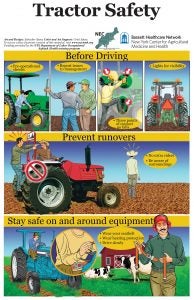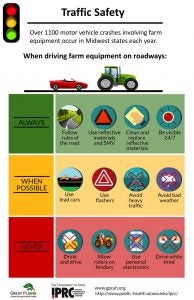Farm safety is on everyone’s mind during the harvest season, and each year in September, there’s even has a dedicated week called National Farm Safety and Health Week to help raise awareness both in the agricultural community and among the public.
Agriculture is one of the most dangerous careers, with about 23 deaths per 100,000 workers. It’s important to focus on safety and highlight the important aspects for your individual operation as safety will look a little different on each farm.
When people think about some of the pillars of farm-related safety, here are the major things that they focus on:
1. Tractor safety
Tractors and equipment of all kinds can be found on nearly every farm. Equipment safety is crucial on the farm as this is where the majority of injuries can happen. Make sure to complete regular inspections and pre-operational checks to prevent the risk of fire or equipment malfunction.

Also, when climbing up or down into equipment always make sure to maintain three points of contact. Both hands should be used to maintain balance and catch yourself if you were to slip. Be sure to have a good foothold and reduce strain on your body while stepping up. Never exit a piece of moving equipment.
2. Rural roadway safety
Whether you are moving equipment on roadways, or live in a rural area with others moving equipment, it’s important to know about rural roadway safety.
All farm equipment should have visible lights and slow moving vehicle hazard signs. Flashing lights help increase visibility.
Farmers on equipment should operate in a safe manner, driving at speeds that are suitable for the equipment. Maintain safety by staying on the roadway when possible, only moving to the side to allow cars to pass when it is safe to do so. Moving large equipment onto an unstable roadside may cause a rollover accident or cause the equipment to get stuck.
If you are driving a vehicle around farm equipment, be sure to give them plenty of space. Farming equipment needs to take wide turns and often have poor visibility, especially behind them and in blind spots. Do not drive recklessly around equipment, and pass at a safe, slow speed.

3. Exposure safety
Agriculturalists can be exposed to a wide variety of hazards that can damage their bodies. Eyes, skin, and lungs are at the most risk for exposure. Chemicals, like pesticides, equipment fluids, and others, can pose a risk to farmers and workers. Make sure chemicals are properly stored according to the manufacturer’s recommendations and ensure anyone utilizing these products knows how to do so safely.
Dangerous chemicals aren’t the only risk of exposure however. Agriculture careers are often outdoor careers, therefore a large risk of exposure that can cause long-term damage is the sun. Outdoor workers should wear sunscreen and protective clothing every day.
Other exposures may be to loud noise, zoonotic diseases, repetitive motion, falls, sips, trips, animal accidents and more. Take the necessary precautions to avoid these hazards.
4. Confined spaces
There is a large focus on grain bin safety but there are many hazards for a variety of confined spaces. Hazardous gasses can found in other places such as silos and manure storage sites. Sensors can be utilized to notify workers of potentially dangerous levels of these gasses.
» Related: Kentucky farmer blessed to be alive after grain bin entrapment
When it comes to grain bin safety, there are a million and one resources available. The main points to follow are outlined by Iowa State Extension:
- Post warning signs on bins and at all entry points to make everyone aware of the hazards.
- Restrict access to bins and piles so that unauthorized people and youth can’t enter.
- Work from outside the bin and above the highest point of grain.
- Aim for zero entry into the bin.
- If entry is essential, use proper safe entry procedures including:
- Locking out and tagging out all grain unloading equipment,
- Having an observer,
- Using a life harness.
Check out this awesome piece of technology being developed to reduce the need for farmers to enter grain bins:
5. Mental health
Lastly, you can’t write an article about farmer welfare in todays day and age without the mention of mental health. Farming isn’t just physically draining, it’s emotionally draining. When your entire livelihood depends on Mother Nature and your income is beholden to every other part of your sector, it can be incredibly stressful. Poor mental health can lead to suicide, and statistics show farmers die by suicide at nearly twice the rate of the general public. It’s important to keep checking in on your own mental health as well as those around you.
Don’t be afraid to reach out for help and lean on others for support when times are tough. The American Farm Bureau Federation said it best, “A healthy farm or ranch is nothing without a healthy you.”
Find farming mental health resources available here.
Michelle Miller, the “Farm Babe,” is an internationally recognized keynote speaker, writer, and social media influencer and travels full time to advocate for agriculture. She comes from an Iowa-based row crop and livestock farming background and now resides on a timber farm in North Central Florida.



